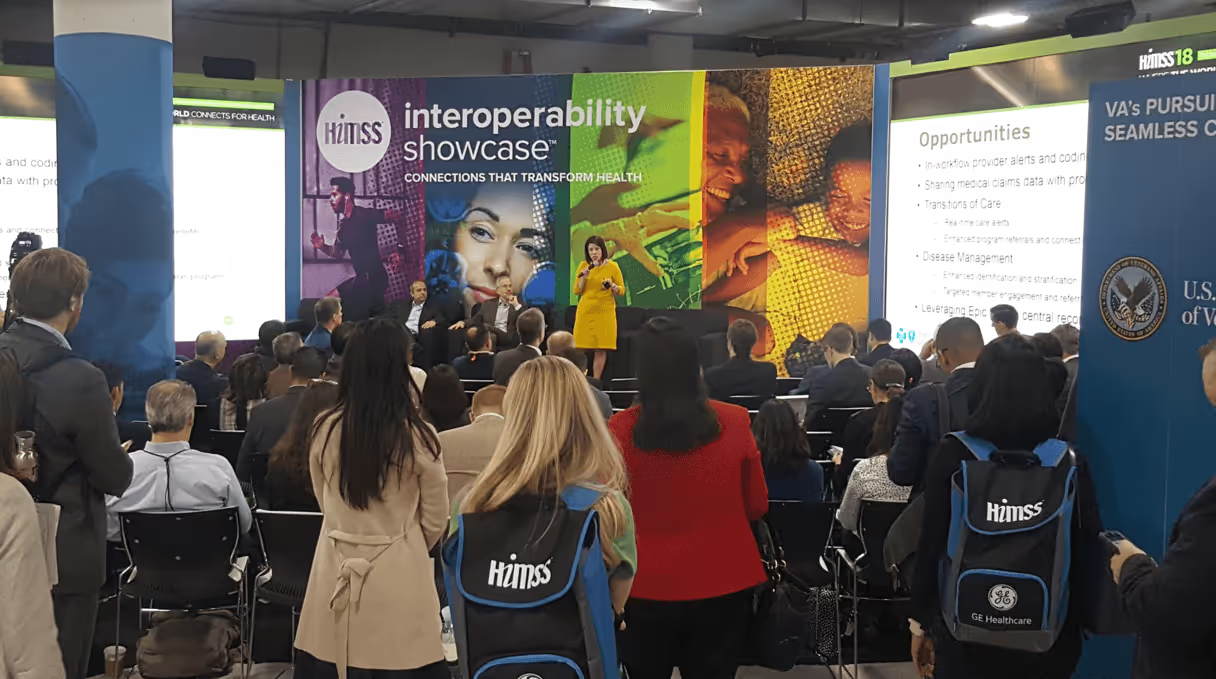
Healthcare IT is anything but stagnant and boring, as displayed at last week’s HIMSS 2018 conference in Las Vegas. As a long-time attendee of the conference and HIMSS Gold Member, QliqSOFT explored all the trends in healthcare IT, both in the space we operate and beyond. Because everything that happens in the industry is important to us, our partners, and clients. We spent time on the exhibit floor, at educational sessions, and attending panels to get a pulse on what the next big thing in healthcare technology is. We’re glad to share our findings with you.
Technology falls flat if it doesn’t work and communicate with other platforms. Every healthcare organization deals with the opportunities and challenges of interoperability. Because no one vendor can do it all, the demand for connecting software will continue to rise. In the Interoperability Showcase, different players in the industry created scenarios to demonstrate how different technologies can work together. These scenarios offered insights on how a patient’s EHR can be shared and updated across a varied care team. One major launch at the conference was Google’s Cloud Healthcare API, intended to be an open API to address interoperability issues.
These three trends are applicable to most any business in the world, and yes they are the future of healthcare technology. First, there’s the data. Most healthcare organizations have it, but they aren’t doing anything with it. When personal identifiers are redacted, this data can be valuable, allowing physicians, researchers, and professionals to see patterns and trends. Then ask why. This could lead to a better understanding of chronic disease and sudden illnesses.One exciting new use of AI is a partnership between Microsoft and its MINE (Microsoft Intelligence Network for Eyewear) platform and expanding it to help better foretell cardiac disease in partnership with Apollo Hospitals, India’s largest healthcare system. This project will develop and deploy new machine learning models to more accurately predict risk for heart disease. This allows patients to start on a treatment plan before a cardiac event occurs.Google and its DeepMind platform are also using AI to better identify cancer. The machine can read images at a quicker, more accurate rate than the human eye.
Patients want convenience, and telemedicine gives them this. This vertical was facing uphill battles until the Centers for Medicare and Medicaid Services (CMS) have finally published a final rule with billing codes to cover these appointments. The demand for these services will only rise. The market is expected to top $113B by 2025. Not only do patients want more convenience, many have to have regular check-ups due to the increase in chronic diseases. Thus, if these care appointments can be handled virtually, all the better. As this business area grows, there will be more competition and partnerships. One collaboration of note, Walgreens is partnering with MDLive to bring telehealth to the public. There is even an on-demand kiosk in a Duane Reade store in Manhattan, in connection with New York Presbyterian.
The rule of thumb now is when not if. The healthcare IT community is shifting toward mitigation versus prevention. Cyber exposure will only increase because of:
The data also paints a picture of continued threats. Ransomware breaches jumped 89% in 2017, and 140 breaches were reported to Department of Health and Human Services (HHS) last year (that’s just what was reported, this number could be much larger). Further, healthcare IT teams may not be ready. A survey found that only 84% of hospitals have a dedicated security leader. If no one is accountable, cybersecurity efforts aren’t going to be successful.Hackers can focus on smaller providers in the coming years, mainly because of the Internet of Things (IoT). This equipment has an inherent weakness - a way through the door for cybercriminals. That’s why all IoT devices must be on a secure, HIPAA-compliant network.
Everyone in healthcare knows that opioid abuse and overdoses are skyrocketing. According to HHS, 116 people die every day as a result of opioid abuse. The Electronic Health Record Association (EHRA) is currently working with legislators regarding policies that could help monitor patient usage and allow for better access and usage of lists of patients who have been provided opioids in the past.
There are various use cases for blockchain in healthcare IT. The unalterable nature of blockchain allows for traceability and better management, as it can’t be changed. Blockchains lets clinicians at least agree on the history, removing the need for a trusted third party. Blockchain is showing potential for managing pharma, medical device supply chain, patient recruitment for clinical trials, interoperability of IoT and medical device data for precision medicine. Blockchain offers a more secure approach to IoT security, using “smart contracts” for maintenance and ensuring tamper-proof device logs.
Secure messaging is a tool healthcare professionals have been using for years. With HIPAA-compliant texting, workflow and patient care are improving. Not only can clinicians communicate with one another, but this can also extend to the patient, offering a direct channel to patients, that has been shown to improve recovery after release. New functionality has been added to platforms like QliqSOFT, including:
Secure texting has also been proven to be a key initiative to reduce ED overutilization and readmissions. It’s making waves in home healthcare, as well, as many of these employees are in the field and must have a secure way to communicate with other providers and their home office. There are many more emerging use cases for secure messaging, like the ability for EMS professionals to connect with hospital staff before they arrive with the patient. This could save time and lives.
The emergence of new technology will continue to expand. Healthcare IT is a continuous environment of evolution. Many factors impact healthcare trends, including the patient experience. We’ll continue to monitor these trends and share our knowledge of the healthcare IT ecosystem.
